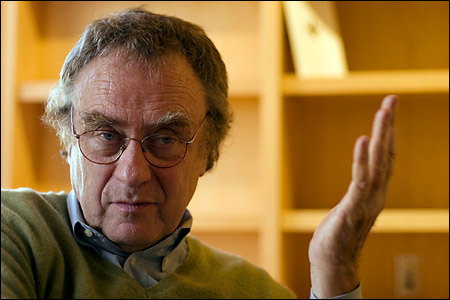‘The caesura of civilization’
Why did visual arts ignore WWII, Holocaust?

As a young college student in West Berlin in the 1960s, Benjamin Buchloh noticed a disturbing dissonance between the art he saw in the city’s galleries and museums and the attitudes of his professors.
Exhibitions of avant-garde art by Europeans and Americans were common in Germany at the time, but in the academy such work was dismissed as unworthy of serious interest.
“I can say without exaggeration that the study of 20th century art in Germany was practically nonexistent.”
The reason for this lack of interest was that academic art departments remained under the influence of an older generation of art historians for whom modern art was still “degenerate art.” But for Buchloh, as for many of his contemporaries, turning one’s back on the art of one’s own time was not an option.
“Part of my motivation for wanting to study modern art was a rebellious impulse. My interest grew in proportion to the inaccessibility of the material.”
Since that time, Buchloh has developed into one of the most respected scholars and critics of modern and contemporary art in the world. His interest in American artists and American art criticism brought him to this country, where he earned his Ph.D. from the Graduate Center of the City University of New York in 1994, studying with the renowned art critic and theorist Rosalind Krauss. This year, Buchloh joined the department of the History of Art and Architecture as the Franklin D. and Florence Rosenblatt Professor of Modern Art.
The author of six books and numerous essays, articles, and reviews, Buchloh is one of the few scholars who focus on the modern and contemporary art of both Europe and the United States. His voluminous output is informed by three overarching critical pursuits. One is understanding the essential differences between the artistic traditions of Europe and the United States during the modern period. Another is understanding the differences between modern art of the early 20th century and the art of the post-World War II period.
A third concern has been understanding the impact, or, rather, the apparent lack of impact, of World War II and the Holocaust on the visual arts in the latter half of the 20th century. This issue has been especially important in Buchloh’s study of Gerhard Richter, whom he considers to be the most important artist to come out of Germany since the war.
Born in East Germany where he was trained as a painter of socialist realist murals, Richter defected to the West in the early 1960s and started over again as an avant-garde artist. In response to his defection, the Communist authorities painted over all his murals, leaving only a few photographs of this earlier work.
In his post-Communist phase, Richter painted in a photo-realist style, using imagery that Buchloh believes addresses questions of historical memory, dealing in an indirect way with the World War II period, or, as Buchloh terms it, “the caesura of civilization.”
Richter is one of the first and still one of the only artists in Europe or the United States to grapple with this issue, an omission that Buchloh finds perplexing.
“In literature and film, you find people going straight to the question, but in the visual arts, this theme seemed for a long time to be outside the parameters of aesthetic expression.”
Buchloh has known Richter for more than 30 years and has conducted extensive interviews with him. He considers interviewing living artists to be an indispensable research tool, although he stipulates that a critic must never assume that the artist is the ultimate authority on his own work.
“I don’t think that speaking to an artist gives you more reliable information, but what I think it does give you is an understanding of the work that is different than you thought it was – deeper and more complex.”
Buchloh wrote his Ph.D. dissertation on Richter, titled “Gerhard Richter: Painting after the Subject of History.” A version was published as a catalogue raisonné for a retrospective exhibition of the artist’s work in 1993. Buchloh is currently working on a new monograph on Richter that he expects to finish by the end of the year. It will be published by MIT Press in 2006.
The new study follows the artist into his more recent abstract phase. Here too, Buchloh sees more complexity in Richter’s work than may immediately meet the eye.
In the work of the abstract expressionists of the 1950s – Jackson Pollock, Barnett Newman, Willem de Kooning – a direct connection was assumed to exist “between the painterly sign and existential experience.” While Richter’s abstract paintings may bear a superficial resemblance to the work of these earlier artists, there is an important philosophical difference, which is apparent through a careful examination of the paintings themselves.
“With Richter it would be hard to say that the mark-making process embodies a specific emotional content. Instead, there is intense ambiguity. No privileged feeling is imposed on the spectator, but rather, there is a full range of options.”
Buchloh sees Richter’s abstractions more as visual equivalents of the music of avant-garde composer John Cage than a reprise of Pollock’s action painting. Visually striking and often beautiful, they convey a deliberate emotional ambiguity.
“They bring the spectator into a moment of crisis in which he must determine what he sees.”
In addition to his ongoing engagement with Richter, Buchloh has been a prolific interpreter of the work of other artists on both sides of the Atlantic and on both sides of the chronological divide of World War II. In his many essays, reviews, and monographs, he has written about artists as diverse as Yves Klein, Joseph Beuys, Ellsworth Kelly, and Andy Warhol.
Currently, Buchloh is drawing upon his comprehensive knowledge of modern art in a yearlong course titled “Modernism (pre, post, and anti-): 1848-1968.” In the spring, he will teach a graduate seminar, “American Sculpture 1965-1975.”




